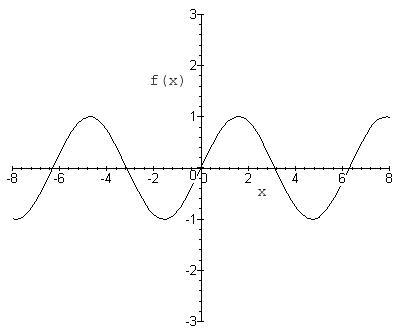(New page: == Periodic Function == A function is periodic if there exists a T>0 such that x(t + T) = x(t). Therefore the function sin(x) is periodic because there exists a T = 2pi such that sin(t+ ...) |
(→Periodic Function) |
||
| Line 5: | Line 5: | ||
Therefore the function sin(x) is periodic because there exists a T = 2pi such that sin(t+ 2pi) = sin(t). | Therefore the function sin(x) is periodic because there exists a T = 2pi such that sin(t+ 2pi) = sin(t). | ||
| − | + | [[Image:Function sin_ECE301Fall2008mboutin.JPG]] | |
== Non periodic Function == | == Non periodic Function == | ||
A example of a non periodic function is a sloped line, like y = 2x + 1. So when the function is shifted by a time T, y(x+T) it is not the same as the function y(x). | A example of a non periodic function is a sloped line, like y = 2x + 1. So when the function is shifted by a time T, y(x+T) it is not the same as the function y(x). | ||
Revision as of 14:08, 5 September 2008
Periodic Function
A function is periodic if there exists a T>0 such that x(t + T) = x(t).
Therefore the function sin(x) is periodic because there exists a T = 2pi such that sin(t+ 2pi) = sin(t).
Non periodic Function
A example of a non periodic function is a sloped line, like y = 2x + 1. So when the function is shifted by a time T, y(x+T) it is not the same as the function y(x).


